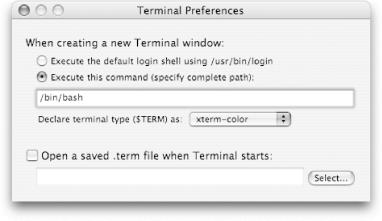Chapter 18. Using the Terminal
The Terminal application
(/Applications/Utilities) is your gateway
between the candy-coated Aqua graphical interface and the no-nonsense
command-line interface that Darwin uses. This book (as well as a lot
of Apple documentation) tends to use the terms command
line and Terminal interchangeably
because, with Mac OS X, to get to the former you must go through the
latter.
Using the Terminal
Each window in the Terminal represents a separate shell process—a command-line interpreter ready to accept your instructions, as described in Section 19.1 in Chapter 19.
Terminal Preferences
The Terminal application’s user settings control not just the application’s look and feel, but the ways you interact with your shells. This section covers the more important application preferences to know about.
Setting a default shell
There are two ways to set a
default shell when using your system,
which are suggested by the “When creating a new
Terminal window” radio buttons found in
Terminal’s Preferences window (Terminal→Preferences,
![]() -,), seen in Figure 18-1.
-,), seen in Figure 18-1.

Figure 18-1. The Terminal Preferences dialog
The lazier way involves activating the “Execute this command” button and typing a shell’s path into the neighboring text field. Henceforth, whenever you open a new Terminal window, ...
Get Mac OS X Panther in a Nutshell, 2nd Edition now with the O’Reilly learning platform.
O’Reilly members experience books, live events, courses curated by job role, and more from O’Reilly and nearly 200 top publishers.

